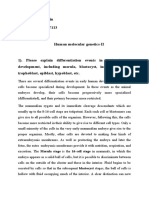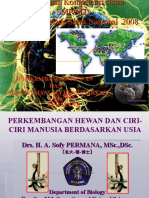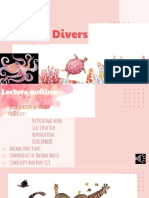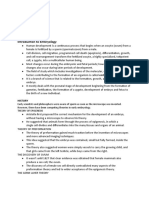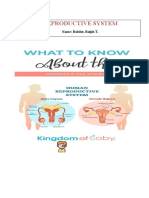Lab Act 1
Lab Act 1
Uploaded by
Ostan Balanquit TeresaCopyright:
Available Formats
Lab Act 1
Lab Act 1
Uploaded by
Ostan Balanquit TeresaOriginal Title
Copyright
Available Formats
Share this document
Did you find this document useful?
Is this content inappropriate?
Copyright:
Available Formats
Lab Act 1
Lab Act 1
Uploaded by
Ostan Balanquit TeresaCopyright:
Available Formats
University of Eastern Philippines
University Town, Northern Samar
COLLEGE OF SCIENCE
Developmental Biology
Laboratory Activity #1
From Egg to Frog: Exploring Embryonic Development
INTRODUCTION:
Understanding the developmental stages of organisms, such as frogs, provides
valuable insight into fundamental biological processes like embryogenesis, cell
differentiation, and morphogenesis. This laboratory activity aims to engage students
in hands-on exploration of the developmental stages of a frog, starting from the
fertilized egg through cleavage and subsequent developmental milestones. The
stages of development between fertilization and hatching (or birth) are collectively
called embryogenesis.
Through this laboratory activity, students will gain practical insights into the
intricate process of frog development, fostering a holistic understanding of
fundamental biological principles. The hands-on nature of the activity will not only
deepen their knowledge but also cultivate a genuine appreciation for the wonders of
embryonic development.
MATERIALS:
- Paper - Pencils - Pens
- Online illustrations
PROCEDURE
Draw as accurately as possible the different stages of the Frog (Rana sp.)
Development. Below are the checkpoints/stages that is needed to be drawn.
1. Fertilization (germplasm, oocyte, sperm)
Involves the fusion of the mature sex cells, the sperm and egg, which are
collectively called the gametes. The fusion of the gamete cells stimulates the egg to
begin development and initiates a new individual. The subsequent fusion of the gamete
nuclei (the male and female pronuclei, each of which has only half the normal number
of chromosomes characteristic for the species) gives the embryo its genome, the
collection of genes that helps instruct the embryo to develop in a manner very similar
to that of its parents.
2. Cleavage: Cleavage is accomplished by a remarkable coordination between the
cytoskeleton and the chromosomes. The zygote cytoplasm is divided into increasingly smaller
cells—first in half, then quarters, then eighths, and so forth. Cleavage occurs very rapidly in
most invertebrates. A frog egg, for example, can divide into 37,000 cells in just 43 hours.
Mitosis in cleavage-stage Drosophila embryos occurs every 10 minutes for more than 2 hours,
forming some 50,000 cells in just 12 hours.
In general, yolk inhibits cleavage. When one pole of the egg is relatively yolk-free,
cellular divisions occur there at a faster rate than at the opposite pole. The yolk-rich pole is
referred to as the vegetal pole; the yolk concentration in the animal pole is relatively low. The
zygote nucleus is frequently displaced toward the animal pole.
In this phase, highlight in your drawing the following:
a. fertilized egg
b. morula
c. blastula (highlight the location of germ cells)
3. Gastrulation
Patterns of gastrulation vary enormously throughout the animal kingdom, all of
the patterns are different combinations of the five basic types of cell movements—
invagination, involution, ingression, delamination, and epiboly.
Gastrulation in the frog begins at a point on the embryo surface roughly 180°
opposite the point of sperm entry with the formation of a dimple called the blastopore.
The blastopore, which marks the future dorsal side of the embryo, expands to become
a ring.
Cells migrating through the blastopore to the embryo’s interior become the
mesoderm and endoderm; cells remaining outside become the ectoderm, and this
outer layer expands to enclose the entire embryo. Thus, at the end of gastrulation, the
ectoderm (precursor of the epidermis, brain, and nerves) is on the outside of the
embryo, the endoderm (precursor of the lining of the gut and respiratory systems) is
deep inside the embryo, and the mesoderm (precursor of the connective tissue,
muscle, blood, heart, skeleton, gonads, and kidneys) is between them.
In this phase, highlight in your drawing the following:
A. blastocoel
B. blastopore
c. ectoderm, mesoderm, endoderm
4. Organogenesis
Organogenesis in the frog begins when the cells of the most dorsal region of
the mesoderm condense to form a rod of cells called the notochord. These notochord
cells produce chemical signals that redirect the fate of the ectodermal cells above it.
Instead of forming epidermis, the cells above the notochord are instructed to become
the cells of the nervous system. The cells change their shapes and rise up from the
round body. At this stage, the embryo is called a neurula. The neural precursor cells
elongate, stretch, and fold into the embryo, forming the neural tube. The future
epidermal cells of the back cover the neural tube.
In this phase, highlight in your drawing the following:
A. notochord
B. neural tube
5. Metamorphosis (Larval Stages to Adult)
Metamorphosis of the fully aquatic tadpole larva into an adult frog that can
live on land is one of the most striking transformations in all of biology. Amphibian
metamorphosis is initiated by hormones from the tadpole’s thyroid gland; the
mechanisms by which thyroid hormones accomplish these changes
Below are the most striking development that will be observed:
The hindlimbs and forelimbs the adult will use for locomotion differentiate
as the tadpole’s paddle tail recedes.
The cartilaginous tadpole skull is replaced by the predominantly bony
skull of the young frog.
The horny teeth of the tadpole disappear as the mouth and jaw take a
new shape, and
the fly-catching tongue muscle of the frog develops.
the tadpole’s lengthy intestine—a characteristic of herbivores—shortens
to suit the more carnivorous diet of the adult frog.
The gills regress and the lungs enlarge
6. Gametogenesis
As metamorphosis ends, the development of the germ cells (sperm and egg)
begins. Gametogenesis can take a long time. In Rana pipiens, it takes 3 years for the
eggs to mature in the female’s ovaries. Sperm take less time; Rana males are often
fertile soon after metamorphosis. To become mature, the germ cells must be
competent to complete meiosis. Having undergone meiosis, the mature sperm and
egg nuclei can unite in fertilization, restoring the diploid chromosome number and
initiating the events that lead to development and the continuation of the circle of life.
ILLUSTRATION / DRAWING. Label parts of the illustration if necessary.
Fertilized Egg (ZYGOTE) MORULA
BLASTULA BLASTOCOEL
BLASTOPORE ECTODERM, MESODERM, ENDODERM
PREMETAMORPHIC TADPOLE PROMETAMORPHIC TADPOLE
Answer the following questions:
1. What determines the genetic makeup of the embryo?
2. What inhibits cleavage? How is it accomplished?
3. How does the establishment of the three germ layers during gastrulation set the stage for
further development and organ formation?
4. What triggers the start of Organogenesis?
5. Enumerate at least 3 developments highlighted during the Metamorphosis stage in Frogs.
6. What process allows germ cells to mature?
You might also like
- The Sea Urchin Fertilization LabDocument5 pagesThe Sea Urchin Fertilization LabAmy HollingsworthNo ratings yet
- 8.introduction To EmbryologyDocument63 pages8.introduction To EmbryologyAhmed OrabyNo ratings yet
- CH 47 - Animal DevelopmentDocument70 pagesCH 47 - Animal DevelopmentSofiaNo ratings yet
- Bio 152 Lab 10 Animal Developemnt Worksheet PDFDocument18 pagesBio 152 Lab 10 Animal Developemnt Worksheet PDFHyena100% (1)
- Animal - Development (Kel 1-5)Document83 pagesAnimal - Development (Kel 1-5)MelatiNo ratings yet
- Principles of Development: Developmental BiologyDocument86 pagesPrinciples of Development: Developmental BiologyPaolo OcampoNo ratings yet
- Open Book Exam Muzzammil HussainDocument22 pagesOpen Book Exam Muzzammil HussainRIFAT RAKIBUL HASANNo ratings yet
- ADocument40 pagesAapi-3826751No ratings yet
- Cleavage Partitions The Zygote Into Many Smaller CellsDocument10 pagesCleavage Partitions The Zygote Into Many Smaller CellssispulieNo ratings yet
- The Development of FrogDocument13 pagesThe Development of FrogRhonnel Manatad AlburoNo ratings yet
- Development of Frog Umanga Chapagain Read OnlyDocument9 pagesDevelopment of Frog Umanga Chapagain Read OnlySubarna PudasainiNo ratings yet
- Introduction & Overview: Developmental BiologyDocument52 pagesIntroduction & Overview: Developmental BiologyArtika Muliany TindaonNo ratings yet
- Sofy Permana: Perkembangan Hewan DAN Ciri-Ciri Manusia Berdasarkan UsiaDocument56 pagesSofy Permana: Perkembangan Hewan DAN Ciri-Ciri Manusia Berdasarkan UsiaDhea Rafsaloka UtomoNo ratings yet
- B2603 ANIMAL DEVELOPMENT - Post Fertilization EventsDocument13 pagesB2603 ANIMAL DEVELOPMENT - Post Fertilization EventssispulieNo ratings yet
- Practical 1 GuideDocument4 pagesPractical 1 Guidea81925487No ratings yet
- GASTRULATIONDocument4 pagesGASTRULATIONProjjal SanyalNo ratings yet
- Activity 6 - Animal Development 23Document10 pagesActivity 6 - Animal Development 23Via IsabelNo ratings yet
- Animal Diversity: Zarah Alaska-VillalonDocument68 pagesAnimal Diversity: Zarah Alaska-VillalonGabrielle Salamanca CastuloNo ratings yet
- Vertebrate Development: Biology II: Form and FunctionDocument41 pagesVertebrate Development: Biology II: Form and FunctionpoovenmoonoosamyNo ratings yet
- Pembelahan Embrio (Cleavage) S2 2017Document47 pagesPembelahan Embrio (Cleavage) S2 2017Desy NataliaNo ratings yet
- Organogenesis: A Brief AccountDocument21 pagesOrganogenesis: A Brief AccountTask BirdNo ratings yet
- Module 5Document10 pagesModule 5Phan MhiveNo ratings yet
- Reproduction in Animals - TB QuestionsDocument7 pagesReproduction in Animals - TB Questionshafsatabarak.rNo ratings yet
- Cleavage in MammalsDocument51 pagesCleavage in MammalsIrfan Azram100% (4)
- Lecture Guide: Introduction To EmbryologyDocument23 pagesLecture Guide: Introduction To EmbryologyAldrin Hardy PabloNo ratings yet
- Ladakh PlaceDocument7 pagesLadakh Placethippeshthippesh275No ratings yet
- 12 Biozoo em CSK 24-25Document35 pages12 Biozoo em CSK 24-25nothingto1000No ratings yet
- 3rd Laboratory Activity AnuraDocument7 pages3rd Laboratory Activity AnuraZia Ammarah SaripNo ratings yet
- Developmental BiologyDocument72 pagesDevelopmental BiologyKshitija KavaliNo ratings yet
- Sexual Reproduction and Meiosis: Four Haploid CellsDocument10 pagesSexual Reproduction and Meiosis: Four Haploid CellsJohnieer Bassem MoferdNo ratings yet
- Gastrulation in FrogsDocument5 pagesGastrulation in FrogsKristiana Marie GuisadioNo ratings yet
- Cell Differentiation and Organogenesis 2Document34 pagesCell Differentiation and Organogenesis 2Dahal Babin100% (1)
- Frog EmbryologyDocument8 pagesFrog EmbryologyklumabanNo ratings yet
- Class 12 Biology Zoology em Study Materials 2022-2023 - P.senguttuvan C.valarmathiDocument64 pagesClass 12 Biology Zoology em Study Materials 2022-2023 - P.senguttuvan C.valarmathiartravels1955No ratings yet
- GASTRULATION-ACTIVITY - DEV-BIO - Bio 102Document6 pagesGASTRULATION-ACTIVITY - DEV-BIO - Bio 102Quentin LopezNo ratings yet
- Principles of Development. Cap 1Document32 pagesPrinciples of Development. Cap 1Gre Vega ÁlvarezNo ratings yet
- Lab 09 HandoutDocument8 pagesLab 09 HandoutHyena100% (1)
- +2 Bio Zoo em 1 6Document34 pages+2 Bio Zoo em 1 6lieb.bhavaNo ratings yet
- Chapter 38 Animal DevelopmentDocument77 pagesChapter 38 Animal Developmentmaria banunaekNo ratings yet
- Animal Development 2Document7 pagesAnimal Development 2dewiNo ratings yet
- How Do Organisms ReproduceDocument42 pagesHow Do Organisms Reproducesanjaysolunke01No ratings yet
- +2 Bio Zoo em 1 6 LessonsDocument34 pages+2 Bio Zoo em 1 6 LessonsMohamed AzeemNo ratings yet
- Special LessonDocument73 pagesSpecial LessonJustine Mangrobang MendozaNo ratings yet
- Act06 Animal Development DiscussionDocument5 pagesAct06 Animal Development DiscussionGlaze HernandezNo ratings yet
- Practical - DEVELOPMENTAL STAGES OF FROGDocument6 pagesPractical - DEVELOPMENTAL STAGES OF FROGtooba tahirNo ratings yet
- Fertilization 200908081743Document71 pagesFertilization 200908081743Min MiniNo ratings yet
- Exp. 5 Drosophila Life Cycle StagesDocument23 pagesExp. 5 Drosophila Life Cycle Stagesnirjal.jhaNo ratings yet
- Prenatal Growth and DevelopmentDocument173 pagesPrenatal Growth and Developmentaparna mohananitha100% (3)
- Pdf&rendition 1Document29 pagesPdf&rendition 1saravanan.kavinilaNo ratings yet
- REPRODUCTIVEDocument12 pagesREPRODUCTIVEBalolot RalphNo ratings yet
- CH 9 ScienceDocument6 pagesCH 9 ScienceRanjana DwivediNo ratings yet
- Camp's Zoology by the Numbers: A comprehensive study guide in outline form for advanced biology courses, including AP, IB, DE, and college courses.From EverandCamp's Zoology by the Numbers: A comprehensive study guide in outline form for advanced biology courses, including AP, IB, DE, and college courses.No ratings yet
- +2 BIO-ZOO-EM - Vol-1 (1-6 Lessons)Document36 pages+2 BIO-ZOO-EM - Vol-1 (1-6 Lessons)Asraf Mohammed Siraj100% (1)
- Namma Kalvi 12th Bio Zoology Study Material EM 221002Document64 pagesNamma Kalvi 12th Bio Zoology Study Material EM 221002prejitjsanthoshNo ratings yet
- Namma Kalvi 12th Zoology Reduced Syllabus Study Material EM 220454Document32 pagesNamma Kalvi 12th Zoology Reduced Syllabus Study Material EM 220454Anitha SNo ratings yet
- Reproduction in AnimalsDocument5 pagesReproduction in AnimalsnagalingammdrtNo ratings yet
- EMBRYOLOGYDocument51 pagesEMBRYOLOGYShiva LakshmananNo ratings yet
- Embryonic Development - WikipediaDocument7 pagesEmbryonic Development - WikipediadearbhupiNo ratings yet
- Development of AmphioxusDocument59 pagesDevelopment of AmphioxusDyah Ayu PuspitasariNo ratings yet
- Zo 103Document5 pagesZo 103Ravi ChauhanNo ratings yet
- ANPATHDocument23 pagesANPATHmwah mwahNo ratings yet
- 1 Musculoskeletal Mind MapDocument1 page1 Musculoskeletal Mind Mapvn6jydy5gkNo ratings yet
- Bone Anatomy Good NotesDocument16 pagesBone Anatomy Good NotesDENACE JnrNo ratings yet
- Chapter 4 Human Histology - Connective TissuesDocument6 pagesChapter 4 Human Histology - Connective TissuesDessirie EnriquezNo ratings yet
- BIO - F5 - KSSM - CHAPTER - 1 - 1.1 and 1.2 ORGANISATION OF PLANT TISSUES AND GROWTHDocument59 pagesBIO - F5 - KSSM - CHAPTER - 1 - 1.1 and 1.2 ORGANISATION OF PLANT TISSUES AND GROWTHwienna1987100% (2)
- Embryogenesis 1Document4 pagesEmbryogenesis 1kopipaym8No ratings yet
- Chapter 6 Anatomy of Flowering PlantsDocument8 pagesChapter 6 Anatomy of Flowering Plantsswayamdey71No ratings yet
- Surgical Instruments 1x1Document9 pagesSurgical Instruments 1x1Nikael Patun-ogNo ratings yet
- Medical Terminology FlashcardsDocument32 pagesMedical Terminology FlashcardsTecito Con GalletasNo ratings yet
- 1 s2.0 S0367253023000804 MainDocument9 pages1 s2.0 S0367253023000804 MainfaelguimaraesNo ratings yet
- Ihs120 - Syllabus Scheme of WorkDocument6 pagesIhs120 - Syllabus Scheme of WorkMazarina insyirah IdrisNo ratings yet
- Respiratory SystemDocument36 pagesRespiratory SystemLovejoy TiñaNo ratings yet
- Earth and Life ScienceDocument14 pagesEarth and Life ScienceEms TeopeNo ratings yet
- Transports Water and Mineral Salts From Root To LeavesDocument2 pagesTransports Water and Mineral Salts From Root To LeavesriyashreeNo ratings yet
- Plant Cells PDFDocument7 pagesPlant Cells PDFMarcus Ben AlgerreNo ratings yet
- Biology Igcse Chapter 2 SummaryDocument2 pagesBiology Igcse Chapter 2 Summarytaliaamjad771No ratings yet
- Seed Germination and DevelopmentDocument14 pagesSeed Germination and DevelopmentDanah Mae AdvinculaNo ratings yet
- Integumentary SystemDocument2 pagesIntegumentary SystemKrystle GopaulNo ratings yet
- q3 Science 10 w1Document5 pagesq3 Science 10 w1Kimi LegsonNo ratings yet
- Autopsy Report For Raymond MattiaDocument12 pagesAutopsy Report For Raymond MattiaMichael CooperNo ratings yet
- 2-Development of TeethDocument52 pages2-Development of Teethkhatoonhania26No ratings yet
- DLL Science 4 Q2 W1Document8 pagesDLL Science 4 Q2 W1Sheena Claire dela Pe?No ratings yet
- 7 Structural Organisation in Animals - Notes - SampleDocument2 pages7 Structural Organisation in Animals - Notes - SampleManish KumarNo ratings yet
- The Life of A Flowering PlantDocument19 pagesThe Life of A Flowering PlantMedinaNo ratings yet
- Lab Report Intro Result ConclusionDocument3 pagesLab Report Intro Result ConclusionJohn Mark QuiambaoNo ratings yet
- The Connective Tissue ReviewerDocument4 pagesThe Connective Tissue ReviewerSasukeNo ratings yet
- Cell NotesDocument15 pagesCell NotesJaniceNo ratings yet
- Mod 8 ZooDocument10 pagesMod 8 ZooLM Tricia T. DE LA CRUZNo ratings yet
- Medical TerminologyDocument7 pagesMedical TerminologyJessiree Joyce Layosa RaganitNo ratings yet
- Cell JunctionsDocument27 pagesCell JunctionsEgg TorNo ratings yet






